All Your Clean Food Dirty Girl Meal Plan Questions Answered (FAQ) + Instant Pot Poppy Seed Carrot Cake Steel Cut Oats
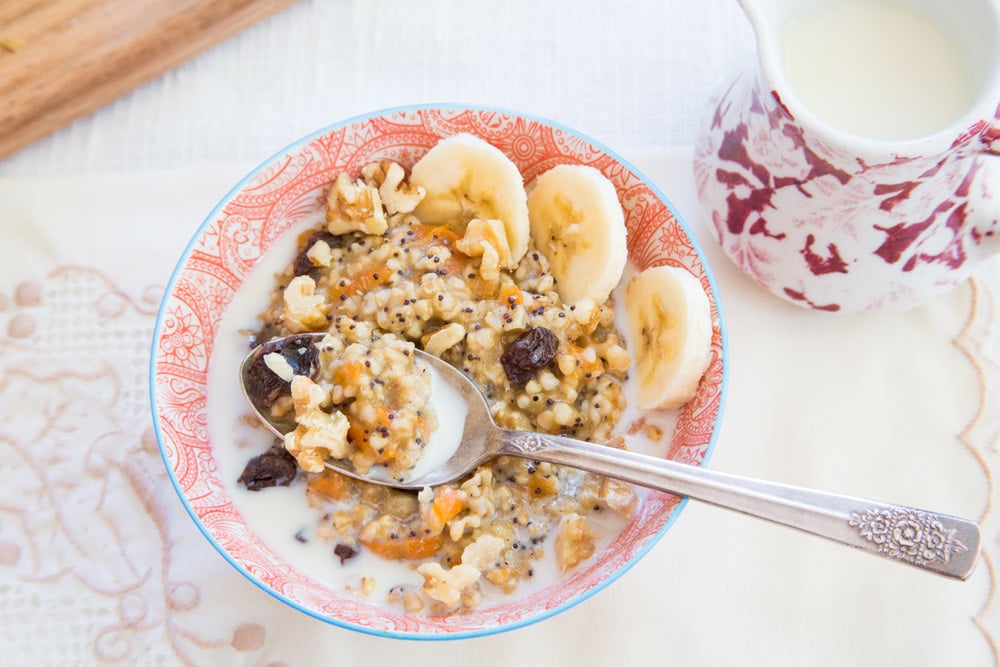
By Molly Patrick
Sep 9, 2017,
By Molly Patrick
Sep 9, 2017,
We created our weekly Plant Fueled Meal Plans to give people a structured, nutritionally diverse and delicious blueprint that makes eating a healthy and well-rounded plant-based diet doable, exciting, customizable, interactive and fun.
When people are ready to eat more whole, unprocessed plants and less of everything else, our meal plans are there to tell them exactly how to do it each and every week.
We get a lot of questions about our meal plans so I’ve rounded up the most frequently asked questions (FAQ) to give you all the answers in one place.
Let’s start by breaking down the plans to show you what they consist of.
- Menu at a Glance
- Meal Plan Notes and Tips
- Detailed Grocery List
- Detailed Prep Instructions for Batching Day
- Batch Cooking Recipes (7 – 8 recipes that you will make on your batching day)
- Nightly Meal Instructions (instructions for 5 delicious and super fast meals using items that you made on your batch cooking day)
Each week’s recipes and plan is handcrafted by me, Tamie Spears and Jennifer Pollock (aka Dirty Plant Wizards). Each plan is a mix of new recipes and past favorites. But mainly new recipes, because being in the kitchen, creating mouthgasm-inducing plant based food is what lights us up.
We don’t use recipe software, grocery list generators or apps to come up with the meal plans. We use a pen and paper and Google Docs. And then we put it into our amazing meal plan classroom where you will access them each week and set how many portions of each meal you want to make.
We create each plan so that you get nutrient diversity, little-to-no unused ingredients at the end of the week, and damn delicious meals that you and your family will love. We also have the best community of people who follow along each week, sharing pictures and updates all week long.
Our meal plans are free of meat, dairy, oil and processed foods. They contain a wide and varied range of vegetables, beans and legumes, whole grains, nuts and seeds, fruit, and minimally processed plant foods, like sprouted bread and tofu. On occasion we use a bit of sweetener in the form of maple syrup and coconut sugar, but these can be easily omitted.
For a free test drive of our classroom and to try out a meal plan, you can sign up for a trial here.
Okay – onward with the Q+A!
Click on the questions below to jump directly to the answers.
- How much do the meal plans cost and when will I get my first plan?
- The meal plans offer dinner meals, what am I supposed to eat for breakfast and lunch?
- Can’t I just use free recipes from your blog and not sign up for the meal plans?
- How many people do the meal plans feed?
- Are the ingredients hard to find if I don’t live in the U.S.?
- Are the ingredients hard to find if I live in a small town in the U.S.?
- I want to sign up for the meal plans. What are some staple ingredients that I will need?
- How much will I spend on groceries each week?
- Are the recipes kid friendly?
- I can’t eat soy, nuts or gluten, can I still do this?
- What kitchen tools will I need to do the plans?
- How long will it take me to batch cook each week?
- Do you give the nutritional and caloric breakdown of the recipes and meals?
- I see that the nightly meal instructions don’t give portions. How do I know how much to eat?
- What containers should I use to store my food in?
- Can I freeze the food if I don’t eat it all?
- Do I have to print the meal plan? There are so many pages!
- Can I gift a meal plan subscription to someone else?
How much do the meal plans cost and when will I get my first plan?
The meal plans are $25 / month for one month, $20 / month for three months, and $18 / month for twelve months.
A new meal plan opens in your classroom every Friday by 12:30 AM Pacific Time.
Your classroom will be loaded up with the most current meal plan as soon as you sign up.
The meal plans offer dinner meals, what am I supposed to eat for breakfast and lunch?
Leftover meal plan food is awesome for lunch! Just set a couple more portions for the meals that look tasty for lunch and you will be covered!
I recommend making a batch of Steel Cut Oats on your batching day for breakfast throughout the week (see today’s recipe!). I also recommend fruit and a green smoothie or green juice in the morning. If you need more breakfast ideas, this post will help you.
Bottom line, the meal plans are not just for dinner. Along with a batch of oats or other breakfast item, the meal plans will carry you all week long without having to cook or go out to eat.
Can’t I just use free recipes from your blog and not sign up for the meal plans?
You can definitely do this! Testing the free recipes on the blog is a great way to dip your feet into the yummy plant based waters.
The magic of the meal plans isn’t the recipes alone, it’s the structured nature of the plans that make them so powerful and life changing.
So by all means, start with the free recipes and when you’re ready to go further, sign up for the weekly plans!
How many people do the meal plans feed?
You can set the meals to make 0 – 10 portions and all the recipes and the grocery list will scale accordingly, so it all depends on how many portions you want to make!
Are the ingredients hard to find if I don’t live in the U.S.?
We have people from all over the world who get our meal plans, including Australia, U.K., Cyprus, Cayman Islands, Ireland, Canada, Finland, Germany, South Africa, New Zealand, Singapore, Netherlands, Dubai, Japan, Hong Kong and Brazil. It might take a little creativity and the recipes and meals won’t be exactly as they are written, but you can make it work and they will still be yummy.
Are the ingredients hard to find if I live in a small town in the U.S.?
If there’s a health food store in your town you will be fine, even if it’s a small health food store. If there’s a regular grocery store in your town you should be nearly fine. If you can’t find a particular ingredient, you can always order it from Amazon. Bottom line – you can make it work if you live in a small town.
I want to sign up for the meal plans. What are some staple ingredients that I will need?
The majority of the plans are made up of fresh veggies, herbs and spices, beans and legumes, whole grains and nuts and seeds. You will do most of your grocery shopping in the produce and bulk bin section. I recommend waiting until you sign up for the plans before you buy any of this stuff because these items are easy to find and they are best when you buy them close to the time you will use them. Whole grains and dried beans and legumes last a long time, but if they are too old, beans won’t get soft, no matter how long you cook them. So hold off on buying these items for now.
Here are 10 staple packaged items that you will use often (in no particular order). Feel free to purchase these anytime because they last for a long time.
- Apple cider vinegar: find this in the vinegar section.
- Brown rice vinegar: find this in the vinegar or Asian section.
- Ume plum vinegar: a delicious briney vinegar that adds a nice umami flavor to dishes; it’s salty, not sour so it’s not like any other vinegar. Find this in the Asian section at your health food store.
- Coconut Aminos: this is made from coconut tree sap. It has a sweet taste that’s really good for balancing out acid in recipes. This is not the same as soy sauce. Soy sauce is salty, this is sweetish. You will find this near the soy sauce.
- A variety of canned beans: sometimes we use dried beans for the plans and sometimes we use canned. Regardless, it’s always good to have a variety of canned beans on hand. Black, white, pinto, kidney, garbanzo – you will be using them all.
- Mustard: dijon and yellow.
- Unsweetened non-dairy milk: my favorite is Westsoy unsweetened plain because it has two ingredients: organic soybeans and water. If you need extra calcium, buy calcium enriched non-dairy milk.
- Tahini: sesame seed butter / tahini made with toasted sesame seeds is less bitter then tahini made with untoasted sesame seeds. Find this with the rest of the nut and seed butters. You can also find great deals on tahini at Middle Eastern grocery stores. And while you’re there, pick some of the most heavenly dried dates you will ever find!
- Canned, jarred or boxed tomato products: tomato paste, crushed tomatoes, tomato puree and diced tomatoes are all handy to have in your pantry. Make sure your tomato products do not have salt, sugar or oil.
- Miso, yellow or white (there are lots of different kinds of miso, yellow or white is typically used in dressings and sauces): look for organic miso that has been aged at least 2 years to get the probiotic benefits. Find this in the refrigerated section of your health food store or grocery chain that has a health food section.
If you can’t find any of these ingredients in your town, you can order them from Amazon.
If you’re brand new to healthy grocery shopping, here’s a post to help get you started.
How much will I spend on groceries each week?
This all depends on where you live. People who live in Canada pay far more for groceries than we do here in the U.S. But here’s what I can tell you with certainty. If you are brand new to this way of eating, your first three meal plan grocery store trips will be more than you usually spend. However, once your kitchen is stocked with staple ingredients, you will be saving money each week on groceries because you will only buy what you need and you won’t waste ingredients.
You will also save money throughout the week because you won’t be eating out or relying on expensive packaged food. Cooking healthy plant based food from scratch is always more cost effective than going out to eat or buying packaged meals. From what I’ve heard from meal planners, the first few trips to the grocery store for a family of four is usually around $100 – $120 (USD).
After the first three meal plans, groceries are anywhere from $6 a week to $50 a week. I’ve seen many people save literally hundreds of dollars per month on food by using these plans. So the initial cost of getting your kitchen stocked is worth it because it gets cheaper the longer you do this and the cost of the meal plans ($20 a month) will pay for itself over and over.
It depends on your kiddo but we have lots of people who report that their kids like the food. Some things they will like. Some things they won’t. The cool thing about the plans is we give new recipes every week so when a recipe jives with your little one, make a note and save the recipe to add to your rotation. If they don’t like four things in a row, maybe they will like the fifth thing you give them. Keep trying and don’t give up! Getting your babes to eat healthy plant foods from the get go is one of the best things you can do for them!
My sister used to tell my nephew that if he didn’t like the food she fixed then he could have an almond butter and jelly sandwich. That was the only choice she gave him. It made him try things that he initially didn’t want to try. I don’t have kids, but I thought it was genius.
There are lots of moms who get our meal plans, so feel free to connect with them in the private Facebook group and ask what their kids think about the plans.
Here’s an interview with I did with Dr Yami, a plant based pediatrician on kids and food.
I can’t eat soy, nuts or gluten, can I still do this?
Absolutely! We have lots of meal planners who have food sensitivities and do just fine. Our plans don’t rely heavily on gluten, soy or nuts, so you won’t have to come up with subs for every recipe or meal plan. When you do need substitution ideas, our private Facebook group is a great resource. Subbing seeds or beans for nuts is a common fix. Subbing gluten free grains for grains that contain gluten is easy. Swapping out mushrooms or eggplant for tofu and vice versa usually works well.
Our recipes and plans are forgiving and versatile, so if you have food sensitivities, it just takes a bit of creativity and you will do great! You can always email us here with a specific ingredient that you need sub ideas for and we’ll help you.
As a side note, if you have no idea whether you should eat soy or fear soy, watch this video ASAP!
What kitchen tools will I need to do the plans?
I’m not a kitchen gadget person and this is reflected in the meal plans. If you have some skillets, pots, pans, a cutting board, a sharp knife, a blender, some baking sheets, some mixing bowls and a salad spinner you can knock out the meal plans.
If you have an Instant Pot (or other electric pressure cooker) and a food processor, you will knock them out faster and easier. Bottom line – the recipes aren’t fussy and you don’t need fancy equipment.
Below are two posts that go over the kitchen essentials.
How long will it take me to batch cook each week?
This greatly depends on how experienced and comfortable you are in the kitchen. If you’re familiar with batching, it will take you between 2 and 3 hours. If you’re not experienced it will take you longer. Here’s what I can tell you with certainty. You will get faster and faster each week you batch. Plus, the time you spend in the kitchen batching is time you will not spend in your kitchen throughout the week. You’re essentially spending time upfront to make sure you can easily and effortlessly eat like a plant based boss all week long.
The people who do the best on the meal plans view their batching sessions as an investment in their health and they build it into their routine. They make it non-negotiable and they happily put in the time. This is about taking responsibility for your health and you can’t do that without spending time in your kitchen, my dear. Your health literally starts in the kitchen.
Here are two posts I wrote about helping you shave time off your batch cooking. Read these before your next batch session and put my tips to use. They will help you.
Meal plan batching inspiration by Lyndsey
Also, you will be eating lots of greens when you follow the meal plans. Here’s a video I did about the best way to wash, dry and store those greens.
Do you give the nutritional and caloric breakdown of the recipes and meals?
The short answer is no. When you switch to eating a Whole-Food Plant-Based diet, the focus is on the quality of calories not the quantity of calories. Giving you the breakdown of calories and macronutrients will only keep you stuck in the diet mindset.
Here are two posts I wrote that go more into this:
I see that the nightly meal instructions don’t give exact portions. How do I know how much to eat?
I’m going to make this really simple for you.
Eat when you’re hungry and stop eating when you are no longer hungry and before you feel full in your tummy.
If you’re always really full after a meal, add a quarter less to your plate the next time you eat and see how you feel. If you’re not feeling full enough after you eat, add a quarter more to your plate the next time you eat and see how you feel.
This is all about getting in tune with your natural hunger signals. Tweak your portions until you find your sweet spot. Everyone is different and your sweet spot will likely change from time to time depending on the kind of day you’re having.
Practice listening to your body, honoring your body and eating when you’re hungry and stopping when you are no longer hungry.
No need to overcomplicate this, lover!
What containers should I use to store my food in?
I might not be the best person to ask because I’m not at all fussy about stuff like this. I wash all my food containers (like almond butter, tahini, etc..) and use those for food storage. Apart from that, I use plastic storage containers in various sizes that I’ve picked up at Ross, yard sales and thrift stores. To get started with the meal plans, plan on having about six medium size containers and four larger containers.
Can I freeze the food if I don’t eat it all?
All of our recipes in the meal plans are noted with a snowflake icon if they freeze well. Roughly 95% of the meal plan food freezes like a dream. Soups, sauces, grains, beans, casseroles, dressings – they all freeze well. Fresh veggies are the only consistent exception that don’t freeze well. When you thaw out our sauces and dressing, they tend to separate a bit. An easy fix is to place them in the blender after they thaw and blend until they are creamy and smooth again.
If you have extra produce that needs using up at the end of the week, the best thing to do is juice it and drink it down. Tomatoes, beets, carrots, cucumbers, celery, citrus, greens, ginger, lettuce – all of this juices beautifully and floods your cells with nutrients.
Between freezing and juicing, you shouldn’t have much food or ingredients go to waste. If you do find you’re tossing stuff out at the end of the week, tweak the plan and make less food next time. Easy peasy.
CanI print out the recipes from my classroom?
Yes! You can print out the whole meal plan or just the recipes – easy peasy.
Can I gift a meal plan subscription to someone else?
We are currently working on this and it should be ready by December 2019.
Okay! If you still have questions, I suggest signing up for the trial and see how you like it! Gathering information is awesome, but taking action and trying them out is the only way you will ever know if the weekly Plant Fueled Meal Plans will work for you and your family.
Here’s the link to sign up when you’re ready
Today’s recipe is a perfect complement to the meal plans. Add this to your breakfast routine and you will be a happy camper all week long.

Ingredients
- ½ cup steel cut oats (100g)
- 2 cups water (475ml)
- 1 cinnamon stick (or 1/4 teaspoon ground cinnamon)
- ½ cup grated carrot (60g)
- 1 tablespoon coconut sugar (optional)
- ¼ teaspoon ginger powder
- ¼ teaspoon cardamom powder
- ⅛ teaspoon ground nutmeg
- 2 teaspoons vanilla extract
- 1 tablespoon poppy seeds
- ¼ cup raisins (50g)
- Non-dairy milk and chopped walnuts for serving
Instructions
- Rinse the oats in a fine mesh strainer. Tap the strainer against the sink to remove excess water and transfer the oats to your Instant Pot.
- Add the water, cinnamon stick, grated carrot, coconut sugar, ginger powder, cardamom powder, ground nutmeg and vanilla. Stir once.
- Lock the lid into place and make sure the nozzle is pointed in the sealing position. Use the manual setting and set the timer for 10 minutes. Use the natural release method when the timer is up.
- When all the pressure is out, remove the lid and stir in the poppy seeds and raisins. Your oats will look watery at first. This is okay - they will thicken as they cool. Allow them to cool completely before you store them in your fridge. Feel free to keep the cinnamon stick in your oats. It will continue to flavor them as they set (just don’t eat it).
- Serve warm with a bit of non-dairy milk and chopped walnuts.


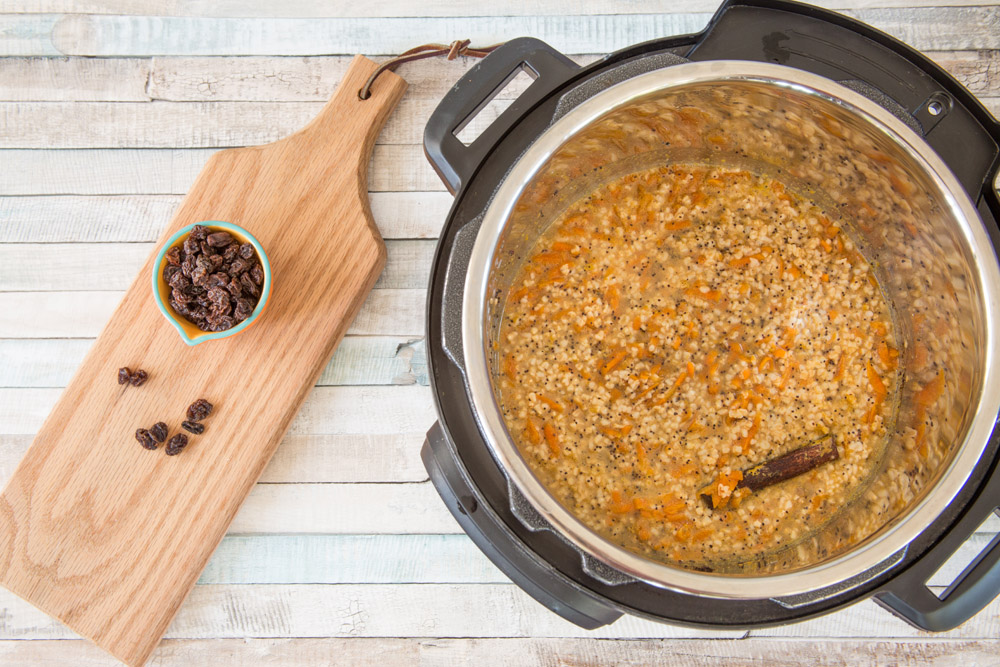
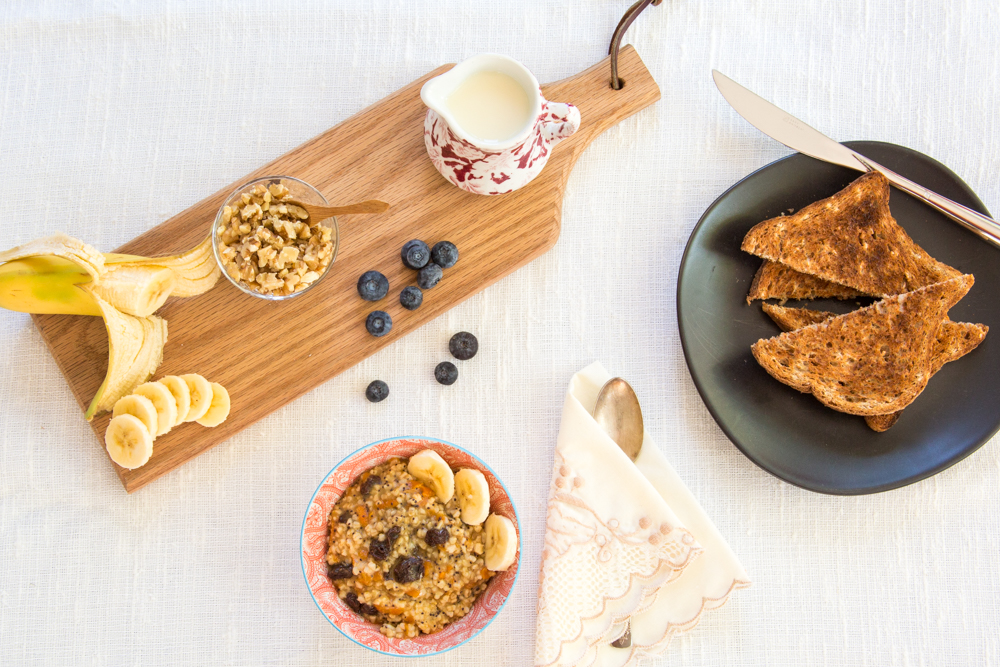
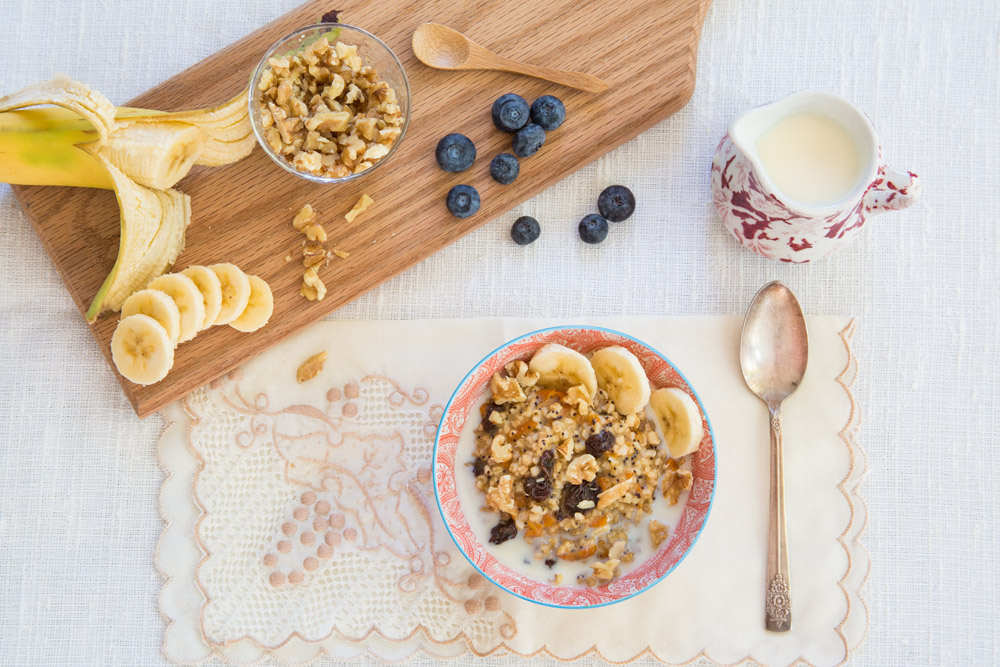
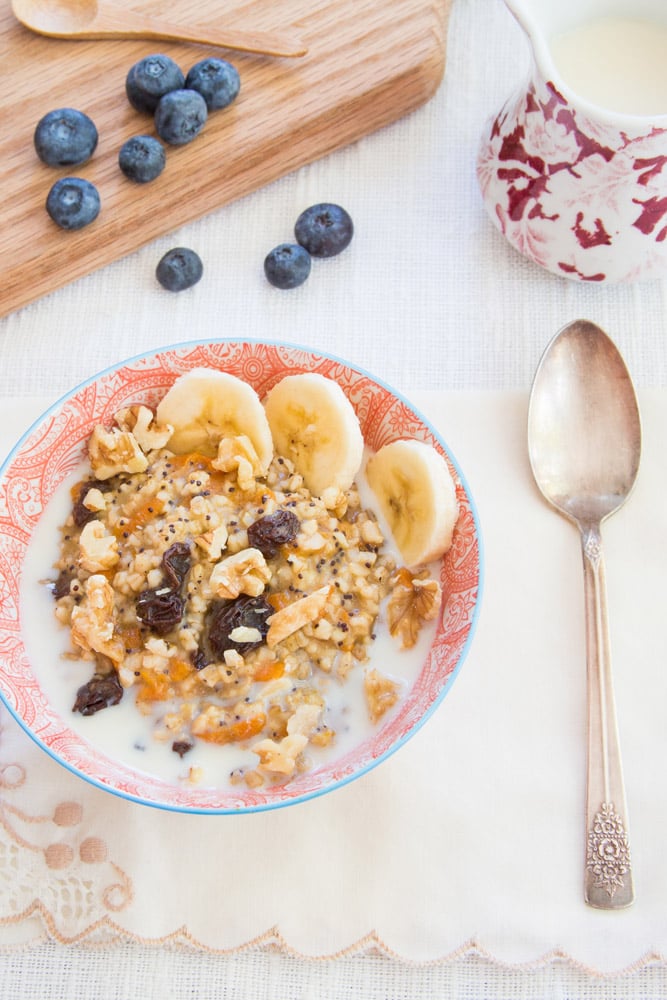


Wishing you a happy weekend. May it be full of getting out of your comfort zone and saying yes to a new plan!
Xo
Molly
9 Comments
Leave a Comment
You may also enjoy...
Love the food that loves you back
Get instant access to thousands of plant-based recipes and meal plans, no credit card or perfection required.






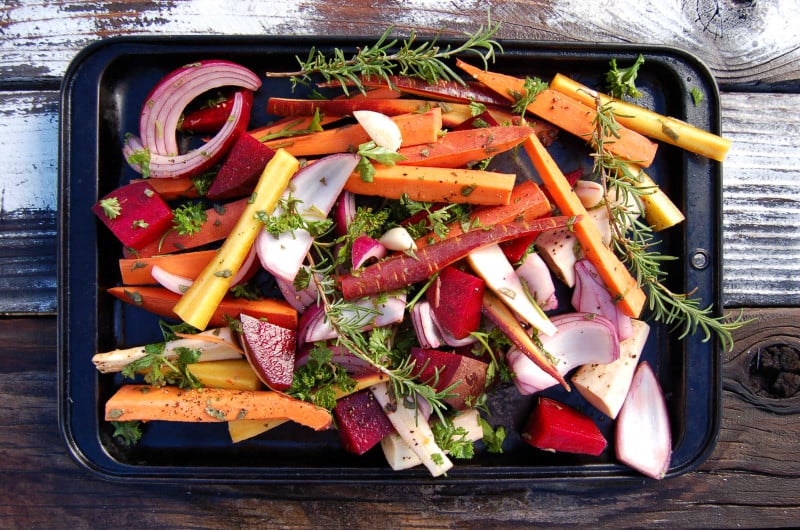
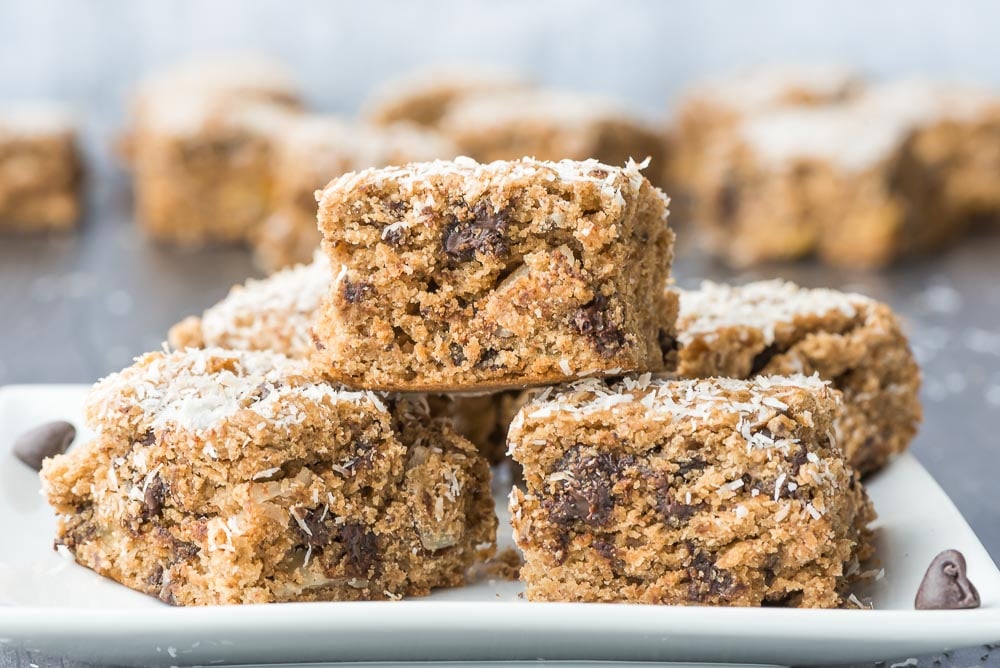






Thanks for this! So informative, you rock! Regarding the recipe, I’m grain free and I use buckwheat groats instead of oats.. do you think it could be substituted for this recipe? Thanks! 🙂
Hi! Would love to know approximately how many servings this makes – looks awesome!
Hi Joanne,
I made them this morning and my husband and I ate the entire batch, so two adults.
Karen
Team Dirty Girl
Can this be made in a slow cooker or on the stove top easily? It sounds delicious!
Hi Samantha,
Definitely! Follow stove top directions for steel cut oats that come on the package and add the other ingredients to make this wonderful version of oatmeal. A slow cooker would work just fine too.
Karen
Team Dirty Girl
Nice repost. Thank you!
Karen
Team Dirty Girl
Totally delicious, Molly, thank you!!! I just added a pinch of sea salt to mine to bring out the flavour. Have you done a blog post on why you love your Instant Pot? I’m wavering over buying one and would love to hear your thoughts. S x
Hi Sophie, Thanks for posting that these were a win for you! Molly has two blog posts on the Instant Pot that you should check out. Part 1 and Part 2. ~Karen
ADORED this recipe. So nourishing, warmly spiced, and filling. Will add a pinch of sea salt next time, as well, like another commenter mentioned. Double the recipe to have enough for an extra breakfast. I’m making this for my girlfriends when we go on retreat next month for sure. Paired with some lovely whole grain bread, nut or seed butter and fresh fruit this will be lovely.